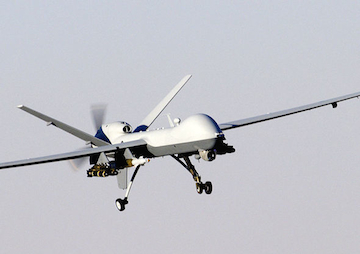Obama Will Finally Release Information on Civilians Killed by Drone Strikes — Will It Be Accurate?
The administration is reportedly prepared to disclose that 100 civilians have been killed in the strikes, but critics argue that the number is much higher. An MQ-9 Reaper unmanned aerial vehicle prepares to land after a 2007 mission in Afghanistan. (Staff Sgt. Brian Ferguson / U.S. Air Force)
An MQ-9 Reaper unmanned aerial vehicle prepares to land after a 2007 mission in Afghanistan. (Staff Sgt. Brian Ferguson / U.S. Air Force)
An MQ-9 Reaper unmanned aerial vehicle prepares to land after a 2007 mission in Afghanistan. (Staff Sgt. Brian Ferguson / U.S. Air Force)
The U.S. is not officially at war, which is why civilian deaths caused by drone strikes throughout the Middle East are labeled “collateral damage.” And despite President Obama’s assurance that information is “checked, double-checked, triple-checked” before a drone strike is carried out, he has publicly stated that there is “no doubt” civilians have died as a result of these military endeavors.
Now, the Obama administration may finally give some insight into the numbers of casualties. W.J. Hennigan of the Los Angeles Times reports:
President Obama is expected to disclose as early as Friday that U.S. military and CIA drone strikes inadvertently have killed about 100 civilians since 2009 in countries where the United States is not officially at war, according to U.S. officials who were not authorized to speak publicly.
The long-awaited report focuses on the so-called shadow wars in Yemen, Pakistan, Libya and Somalia and only during Obama’s tenure. It covers about 500 drone attacks in all.
The tally does not include civilian casualties for Iraq, Syria and Afghanistan, where U.S. forces have launched thousands of air attacks as part of ongoing wars and where the Pentagon formally investigates allegations of civilian deaths.
One hundred civilian deaths may be the reported number, but is it accurate? Consider, for example, a United Nations report from 2013 that states very different data—it concludes that 400 civilians in Pakistan were killed due to drone strikes, and states that an additional 200 victims were “probable non-combatants.”
The Bureau of Investigative Journalism estimates even higher numbers. For Pakistan, it lists between 424 and almost 1,000 civilian deaths; between 65 and 100 in Yemen; and as many as 47 in Somalia.
The Los Angeles Times adds that Obama is expected to “issue an executive order that would call on his successor to annually disclose the number of civilians killed in drone strikes.” The president’s own record on transparency is weak, however. As Trevor Timm of The Guardian reported last year:
[The Obama Administration’s] constant battle to keep every kernel of information about the drone program secret over the past six years is why it’s so hard to take their claims at face value. This is a White House which infamously promised to be the most transparent in history and instead became one of the most secretive; the executive branch promised similar things in 2013 after a major speech where Obama laid out new “rules” for drone strikes, and in a State of the Union address where he promised to be more transparent.
More than two years later, almost all of the “promises” he made have been ignored or disregarded by the administration. The administration reportedly immediately issued waivers for at least one of the rules in Pakistan and then in Yemen, the two countries where the vast majority of CIA drone strikes take place (the rules never even applied to Afghanistan).
The New York Times, which has sued the federal government over drone strike transparency, reported in March that the administration’s plans to release this data was “too little, too late,” and argued that “America has set a dangerous precedent” when it comes to the secrecy of our drone program.
Why the discrepancy? It may come down to how things are labeled. As The Intercept described last year, in “the complex world of remote killing in remote locations, labeling the dead as ‘enemies’ until proven otherwise is commonplace.” In fact, the documents obtained by The Intercept only directly mention civilians deaths one time, even though these documents show that during one five-month campaign period, “nearly nine out of 10 people who died in airstrikes were not the Americans’ direct targets.”
If the Obama administration does indeed announce that 100 civilians have been killed in these countries as a result of drone strikes, it will be hard to fully fact-check its statement against the numbers from independent groups such as those mentioned above. The Los Angeles Times explains that “[t]he White House is not expected to release names, geographic locations or dates of civilians killed,” which makes it “difficult to check the government’s data.”
Meanwhile, as the number of past civilian deaths is debated, drone strikes continue to destroy lives across the Middle East.
—Posted by Emma Niles
Your support matters…Independent journalism is under threat and overshadowed by heavily funded mainstream media.
You can help level the playing field. Become a member.
Your tax-deductible contribution keeps us digging beneath the headlines to give you thought-provoking, investigative reporting and analysis that unearths what's really happening- without compromise.
Give today to support our courageous, independent journalists.






You need to be a supporter to comment.
There are currently no responses to this article.
Be the first to respond.